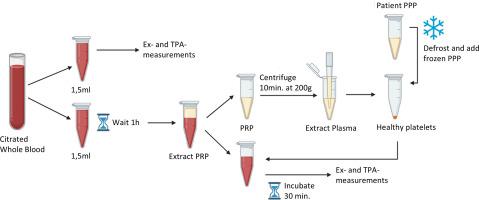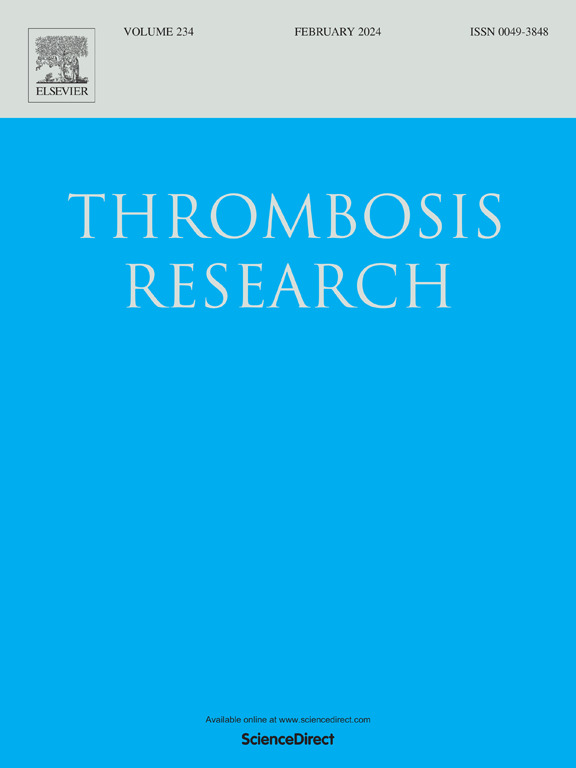储存血浆样品中低纤溶的血栓弹性图评估:一种新的尖峰方法
IF 3.4
3区 医学
Q1 HEMATOLOGY
引用次数: 0
摘要
先天性或获得性纤溶系统失调可导致出血(高纤溶)或血栓形成(低纤溶),增加多器官衰竭的风险。标准的基于凝血的检测提供有限的洞察纤溶状态。相比之下,血栓弹性成像(TEG),全血测定,提供了凝血和纤溶系统的全面评估。虽然冷冻血浆样品可以在以后对血浆凝血因子进行调查,但粘弹性测试(VT)需要立即进行测试。在这项研究中,我们评估了一种新的诊断方法,用于评估健康全血中冷冻血浆样本的纤溶性。方法使用血栓弹性成像(TEG)分析低纤溶性疾病患者的冷冻全血和相应的冷冻贫血小板血浆(PPP)样本。尖峰法涉及将患者来源的冷冻PPP重组为健康受试者血浆耗尽的血液。此外,全球纤维蛋白溶解能力测定试剂盒Lysis Timer®用于评估血浆样品中的纤维蛋白溶解。结果验证研究显示,健康全血VT溶解时间(LT)与加标样品有较强相关性(r = 0.6720, p = 0.0012)。低纤溶患者的组织纤溶酶原激活物试验(LT- tpa)显示,当他们的PPP加入健康全血时,其组织纤溶酶原激活物试验(LT- tpa)的LT显著增加,证实了低纤溶酶活性(健康献血者的LT- tpa全血vs.峰值患者,PPP: 165.7±16.6 s vs. 218.3±39.6 s, p < 0.0001)。溶解计时器试验支持这些发现,表明是血浆因素而不是细胞来源的纤维蛋白溶解阻力。结论峰入法可用于TEG回顾性检测冷冻样品的低纤溶。这种方法对于不能立即室速的临床研究特别有用。本文章由计算机程序翻译,如有差异,请以英文原文为准。

Thromboelastographic assessment of hypofibrinolysis in stored plasma samples: A novel spike-in method
Introduction
Congenital or acquired dysregulation of fibrinolytic system can lead to bleeding (hyperfibrinolysis) or thrombosis (hypofibrinolysis), with increased risk for multi-organ failure. Standard clotting-based assays provide limited insight into fibrinolytic status. In contrast, thromboelastography (TEG), a whole blood assay, offers a comprehensive assessment of the coagulation and fibrinolytic systems. While freezing plasma samples enables later investigation of plasmatic coagulation factors, viscoelastic testing (VT) requires immediate testing. In this study, we evaluated a new diagnostic approach to assess fibrinolysis in frozen plasma samples spiked into healthy whole blood using VT.
Methods
Citrated whole blood and corresponding frozen platelet-poor plasma (PPP) samples from patients with hypofibrinolytic disorders were analyzed using thromboelastography (TEG). The spike-in method involved reconstituting patient-derived frozen PPP into plasma-depleted blood from healthy subjects. In addition, the Lysis Timer®, a global fibrinolysis capacity assay, was used to assess fibrinolysis in plasma samples.
Results
The validation study showed strong correlation between lysis time (LT) of VT in healthy whole blood and spiked samples (r = 0.6720, p = 0.0012). Hypofibrinolytic patients exhibited significantly increased LT in the tissue plasminogen activator-test of VT (LT-TPA) when their PPP was spiked into healthy whole blood, confirming hypofibrinolytic activity (LT-TPA whole blood of healthy donors vs. spike-in with patients, PPP: 165.7 ± 16.6 s vs. 218.3 ± 39.6 s, p < 0.0001). The Lysis Timer assay supported these findings, suggesting a plasmatic factor rather than cell-derived resistance to fibrinolysis.
Conclusion
The spike-in approach can be used to retrospectively detect hypofibrinolysis in frozen samples using TEG. This method is particularly useful for clinical studies when immediate VT is not available.
求助全文
通过发布文献求助,成功后即可免费获取论文全文。
去求助
来源期刊

Thrombosis research
医学-外周血管病
CiteScore
14.60
自引率
4.00%
发文量
364
审稿时长
31 days
期刊介绍:
Thrombosis Research is an international journal dedicated to the swift dissemination of new information on thrombosis, hemostasis, and vascular biology, aimed at advancing both science and clinical care. The journal publishes peer-reviewed original research, reviews, editorials, opinions, and critiques, covering both basic and clinical studies. Priority is given to research that promises novel approaches in the diagnosis, therapy, prognosis, and prevention of thrombotic and hemorrhagic diseases.
 求助内容:
求助内容: 应助结果提醒方式:
应助结果提醒方式:


